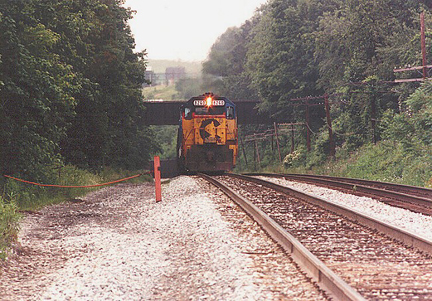17-Mile grade
I knew it was horrible, and 17 miles long, but I didn’t understand why it was there. I also knew it was a Baltimore & Ohio line.
17-Mile grade is part of the original Baltimore & Ohio line to Ohio River; and is part of the Baltimore & Ohio’s dramatic first crossing of Allegheny Ridge.
The Baltimore & Ohio is the nation’s first common-carrier railroad. It was founded in 1827 as an attempt by Baltimore to parry the incredible success of the Erie Canal. It used horses at first.
Baltimore & Ohio wanted to access Pittsburgh at first, but Philadelphia merchants would have none of that.
The B&O couldn’t get a franchise to build to Pittsburgh, so they headed west through Maryland and Virginia (now West Virginia) to the Ohio at Wheeling.
The Allegheny Mountains presented a formidable challenge, particularly between Cumberland and Grafton.
Cumberland to Piedmont is relatively flat, but west of Piedmont is 17-Mile grade westbound.
The line ascends 1,500+ feet (often over 2.5% — the mighty Curve is 1.8%), and crosses the Eastern Continental Divide at Altamont, 2,628 feet.
Worse grades are west. Down-and-up the line goes like a roller-coaster.
The line descends infamous Cranberry Grade (which I didn’t know about) down to M&K Junction, a coal-feeder.
 |
| Photo by Terry Moore |
| Up out of “the hole” at the top of Cranberry. |
I didn’t know about any of those grades; and Newburg and Cranberry face eastbound tonnage. Cranberry is particularly dreadful. (Trains often stalled.)
Getting down the grades is dreadful too.
17-Mile had two runaway tracks, both closed since the advent of dynamic brakes.
A train ran away on Cheat and destroyed both tracks. Only one was rebuilt.
A loaded coal-train ran away on 17-Mile and destroyed a house, killing an occupant.
B&O eventually accessed Pittsburgh, and built another line that crosses the Alleghenies to get to it. It’s the famous Sand Patch Tunnel line. (I reconnoitered that line years ago. It’s way out in the middle of nowhere. I couldn’t find the tunnel — it was on a CSX private-road. Going up Wills Creek I traveled little more than a dirt fire-trail in the faithful Hunda.)
So the original line became a coal-feeder. The line from Grafton to Wheeling became the Fairmont Sub, and another line from Grafton-to-Parkersburg continued to St. Louis.
That line is no longer through, so the original line is rather moribund, except that it moves an incredible amount of coal.
—So much the original line over the Alleghenies still exists — known as the West End from Cumberland-to-Grafton.
About 20 years ago I got a book on B&O’s Royal-Blue line. It mentioned The Royal Blue was built far better than the West End; that B&O managers wished the West End could have been built as well as the Royal Blue. And this is despite the Royal Blue being built on the face of the piedmont. (OLM was on the piedmont — Erlton was down in the flatlands.)
I still had no idea what the West End was; didn’t know it existed — and wasn’t aware Horseshoe Curve was part of Pennsy’s assault on the Alleghenies.
About 10-15 years ago I got a book on the West End; and began to realize how awful it was. I also could see Horseshoe Curve was a grade.
I also had a video-tape of C&O #614 (a 4-8-4) climbing 17-Mile; but still had no idea.
B&O rebuilt quite a bit of the West End — realignment and such — but still all the rollercoaster grades were there.
A second tunnel was built at Tunnelton; the original was only one track, and uphill, which would choke crews.
The new Kingwood Tunnel was two tracks, and not as uphill as the original. The original was left open, for westbounds (descending) only, and eventually was closed. Tunnelton was also an interchange for the West Virginia Northern Railroad, abandoned in 1999.
So the dreaded West End still exists, as does 17-Mile grade. I reconnoitered it about 5-7 years ago, but didn’t see any trains.
It’s no longer through — which accounts for why I didn’t see anything. It’s not like NS’s old Pennsy line, which carries more traffic than any other NS line.
What it carries is empty hoppers west, and loaded coal-trains east. That’s about all. And shoving them up the grades, and then holding them back back down, is frightening.
What impressed me most is how close all the clearances are — compared to Pennsy. The West End is very tight — I doubt it could carry double-stacks.
The Royal Blue is B&O’s line from Baltimore to Philadelphia.


0 Comments:
Post a Comment
<< Home